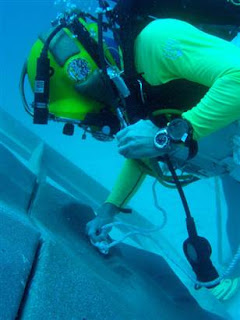 |
| Waiting to die: Pedigree Japanese Akita puppy scratches the window of his cage... moments later he is taken to the gas chamber |
A puppy scratches at a window in a pitiful attempt to escape the horror which is about to unfold.
Minutes later the pedigree Japanese Akita is among a large group of dogs led into a “dream box”, an execution chamber which will be pumped full of carbon dioxide.
As the deadly gas slowly fills the box it takes 10 minutes for the barking inside to die down into heart-breaking whimpers. And as the dogs writhe in agony, it takes another 20 minutes before their twitching bodies are finally still.

The animals have just become the latest batch of the 200,000 cats and dogs which will be gassed to death in Japan this year.
Today a Sunday Mirror investigation uncovers this conveyor-belt of slaughter – which is completely legal and run by the country’s government.
The carnage is happening because of an explosion in the Japanese pet industry, which is worth £20billion a year. There are now 23 million pet cats and dogs in Japan... that’s more than the number of children.
Unregulated breeders sell the latest fashionable breeds, some costing up to £5,000, which fill the windows of thousands of pet shops across the country.
Yet those which can’t be sold, or are too old to be used for breeding, have a piece of red string tied around their neck and are led off to die.
The euphemistically named “dream” boxes where they spend their final moments are fully mechanised gas chambers housed in health centres called hokenjos.
There are 108 in Japan and they each kill an average of 550 animals a day. The gas chambers were invented by scientists in Japan, where Buddhism teaches that all life is sacred. Even a vet will not take an animal’s life. Yet as our pictures show, there is no room for such compassion in Japan’s burgeoning pet trade.

We were granted rare access to one of the execution chambers.
At the single-storey building in Chiba, 50 miles from Tokyo, six stainless steel walled rooms serve as death row for at least 30 dogs.
“It’s quiet now,” says Mr Nohira, the director. “We get especially busy just before the summer when the cages are full of puppies.” Last year more than 5,000 cats and 2,000 dogs were slaughtered here.
Among the dozens of animals frantically pacing the tiny cages are a dachshund, a miniature pointer, a terrier and a poodle.
The red nylon string around their necks indicates they have exceeded the maximum seven-day stay and will have to be killed. Any longer would be “wasting resources”. Hundreds of cats await the same awful fate in another room. That comes at 8.30am sharp every Tuesday and Friday when the animals are forced along a narrow concrete passage into the dream box.
Mr Ishizaki, the operator, a gentle and apologetic man, presses the green button in the control room. He then watches as cylinders release the carbon dioxide.
“When I first did it I was very sad,” he explains. “Now it’s just my job. I don’t dwell on it any more.”
The stench of death fills the air, the metal rails matted with the fur from the tens of thousands of cats and dogs that have already been through the centre.
Puppies and kittens die more slowly because the gas takes longer to penetrate their tiny bodies, Mr Ishizaki explains.
Once dead, the animals are dumped through a hatch into an incinerator. The 600C heat quickly turns them into ash, which is put into white plastic boxes labelled industrial waste.
According to official figures, 90 per cent of abandoned pets are dumped in government pounds each year.
That compares with just nine per cent in the UK.
One reason is because Japanese pedigree dogs have high rates of genetic defects. It means just one or two from a litter will possess the “cute factor”.
Miniature “tea cup” toy poodles are the current trend in Japan. They sell for as much as £2,500, while a puppy with “red” fur was on sale last week in Tokyo for double that. Pet shop chains make millions in profits each year.
DESIGNER GOODS
Some are open until 3am and cater to the businessmen and hostesses who spill out of nearby clubs and buy puppies and kittens to pop into their designer handbags.
Paris Hilton posed outside one such store, OneWan, a couple of years ago among Gucci dog collars selling for £1,400.
Emi Kaneko, director of the Lifeboat charity which has saved 8,000 cats from the gas chambers, says: “Buying a pet is no different to buying a handbag for lots of people in Japan.
“People buy them without any thought and then throw them away like toys.
“It would be better if the Japanese stopped buying pets altogether from the shops – then there would be no puppy mills, no hokenjos.”
Campaigners like Emi are the only hope for many cats and dogs. Small pockets of activists do all they can.
But it is a thankless task in the face of Japan’s appalling animal rights record. Fusako Nogami, of the animal rights group Alive, has spent years trying to expose the black market trade in pedigree cats and dogs bred in “pet mills” across the country.
These tiny pet factories, often in crudely converted houses, are stuffed with squalid cages of pets.
One campaigner, who asked for anonymity, spent two years trying to get the authorities to shut down a pet mill near Fukuoka in southern Japan.
“Hundreds of animals were crammed in a tiny space,” she said. “The stench was overpowering, with carcasses lying around and dead animals being dumped with the garbage.”
The campaigner was arrested and charged with trespassing as she tried to gather evidence. No action was taken against the owner.
Only one breeder has been closed down in Japan in the past five years.
“The current laws are inadequate, ambiguous and weakly enforced,” says Mr Nogami.
For now there seems little chance of that happening. Yesterday in Tokyo one designer dog selling for £4,200 was attracting a throng outside a pet shop window.
As he pawed at the window the onlookers laughed and even took a picture. Then they turned on their heels, leaving the dog scratching at his cage.



























